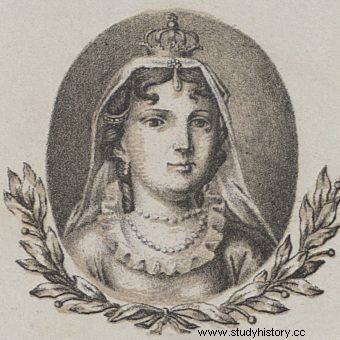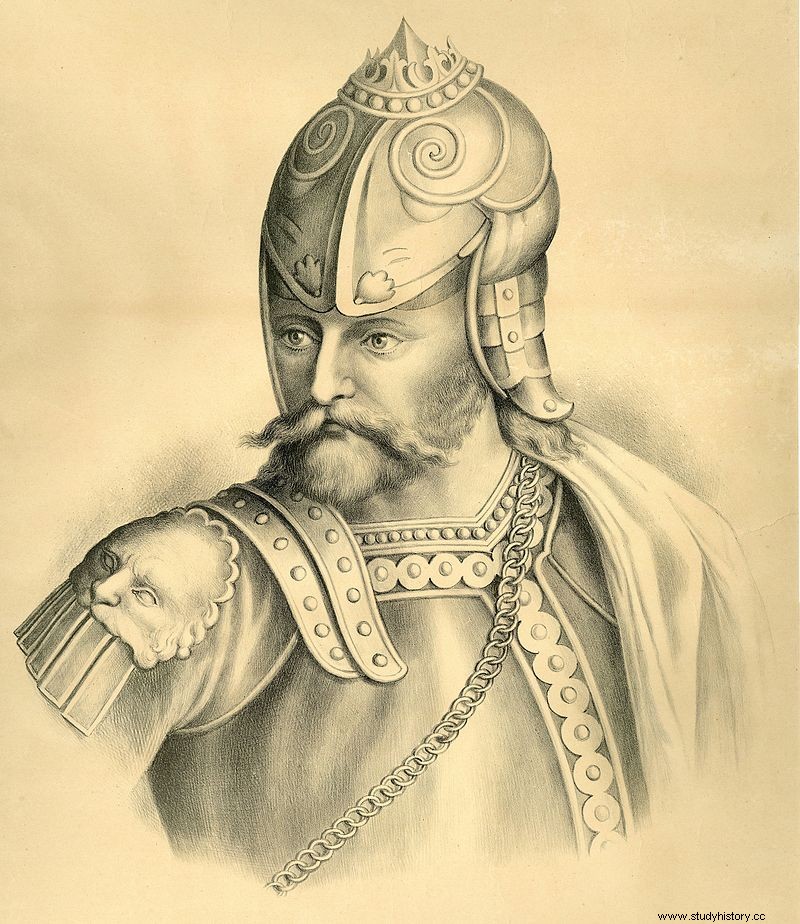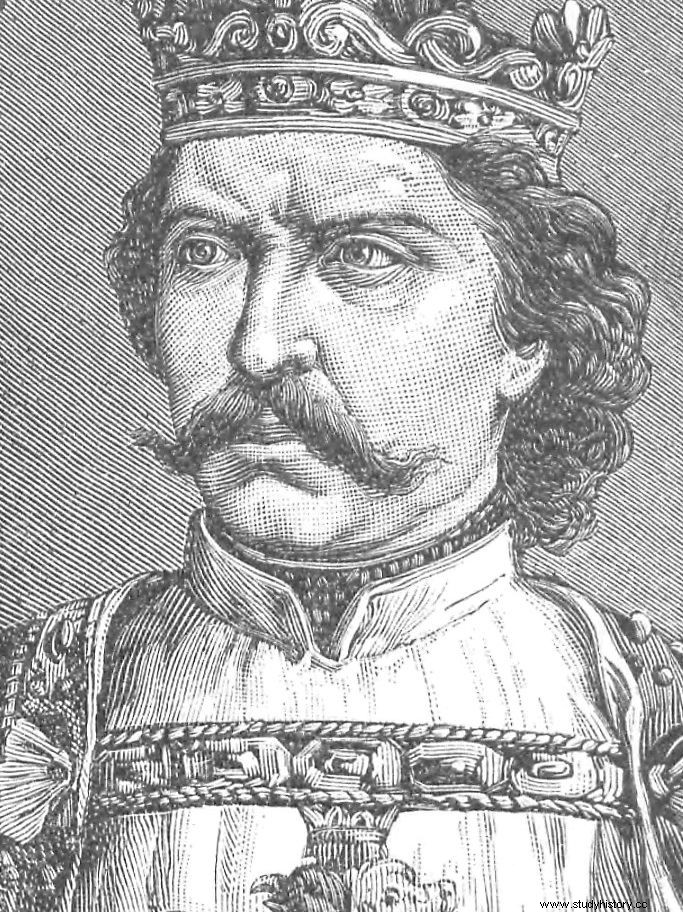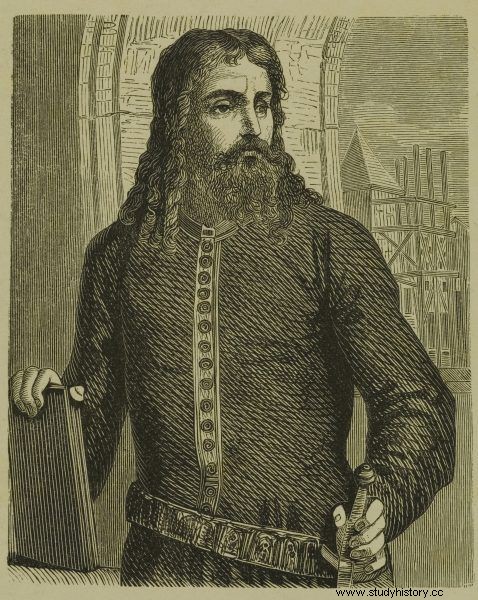For some Aldona, Anna was a devoid of seriousness, who thinks more about games and music than about matters of the throne. Others saw her as a false Christian and the daughter of a traitor. Who was she really? And how did Aldona Anna's wedding to Kazimierz Wielki come about?
Władysław Łokietek was against the wall. Taken in the pinch by two strong neighbors - Czechs who did not accept neither his authority nor the rights to the crown, and the Teutonic Knights, who had recently occupied Gdańsk and had their teeth sharpened on other border lands - he needed a strong partner who would be able to change the rules of the game and protect Poland from the devastating war .

Aldona Anna in a portrait based on the pattern of Michał Stachowicz
His ally was the young son-in-law, Hungarian King Charles Robert, but it could not be counted on that he would go further than mediation and diplomatic pressure. The Hungarians maintained proper relations with the Teutonic Knights, and even entered into an alliance with the Czech dynasty of Luxemburg. An ally ready and capable of turning the tide had to be found elsewhere.
Always willing to take bold steps, and at the same time feeling the breath of enemies on the back of his neck, Łokietek decided to make a pact that is as unconventional as it is dangerous. Some observers would even say:a pact with the devil himself.
Unexpected ally
In 1325, to the surprise and even outrage of the Christian world, he made a deal with the ruler of Lithuania, Gediminas. A powerful commander, considered to be the creator of the Lithuanian power.

Gediminas in the image from the beginning of the 20th century
Gediminas, who has ruled for a decade, subdued a territory that covers not only today's Lithuania, but also two-thirds of today's Belarus. He united the quarreling Lithuanian elites, succumbed to progressive ideas, and even brought monks to his court and considered baptism in the Roman rite (you can read more about it in our other article) . At the same time, he ruled the country with which the Piasts had been in a state of permanent war so far. For many decades, Lithuanians have organized devastating raids on Mazovia. They also happened to reach Lesser Poland and wreak havoc in the very heart of the country.
Łokietek believed that he was the best possible partner. He ignored the warnings that any pact with a pagan would put him under the pillory of European opinion. The king hoped that the Lithuanian would not only end the invasions on his country, but would also quickly convert to Catholicism (which would be regarded as a memorable success for him). Above all:he believed that Giedymin would effectively secure the eastern flank of the Piast state and join the wars with the Teutonic Knights.
The alliance was sealed in a manner commonly used in the Middle Ages. The fifteen-year-old heir to the Polish throne, Kazimierz, was arranged with one of at least six daughters of Gediminas:a girl who, according to an uncertain and late source, bore the pagan name Aldona.
From baptism to marriage. The alleged Aldona becomes Anna
It is known about the young prince that he liked to have fun and did not pay much attention to his studies. And because he was in poor health, his parents constantly indulged him. About the Lithuanian princess, it was written that "she was so devoted to the joys of dancing and merriment that wherever she went on horseback or on a cart, singers with harps, drums, pipes, songs and various melodies always came before her, to the scandal of many". So if Kazimierz wanted to lead a carefree life of a sybarite, then his fiancée certainly did not intend to stand in his way.
Aldona came to Kraków in the spring of 1325. The Traska Yearbook, written in the same century, states that she was baptized on April 30. The later chronicle of Jan Długosz contains a June date. Certainly, the condition for baptism was one of the points of the Polish-Lithuanian agreement. The wedding of the future Christian king with a pagan was out of the question.

Władysław Łokietek in the portrait of Fr. Pillati.
If you believe the records, instead of gold or silver, Aldona brought Polish prisoners of war from Lithuania, who had been abducted by her father and earlier princes for years. There were supposed to be as many as 24,000 of them. Information about the mass amnesty is provided by only one late source, but historian Andrzej Marzec emphasizes that it should be treated as relatively reliable.
Candidate for Queen
The wedding took place only a few months later, on October 16. The reasons for the delay are unknown. Perhaps it was about the age of the bride, about inviting the right guests, or about the earlier fulfillment by the Lithuanians of the condition of releasing prisoners. The Krakow court could also come to the conclusion that the king's wife should first be acquainted with the Polish language (contrary to what the series "Crown of Kings" suggests - she certainly did not know it), with the local customs and rules of the hastily adopted Christian faith. Jan Długosz claimed that the Cracow bishop, Nanker, took care of these accelerated lessons in etiquette, religion, and probably also the local speech.
An expert in the history of Giedymin and his family, Jan Tęgowski, estimates that Aldona was about 12 or at most 14 years old when she came to Poland. According to Andrzej Marzec, she was roughly the age of Kazimierz - so she was about 15 years old. She was not for sure, like her serial counterpart, an adult woman, but also - by medieval standards - she was no longer a child.
"She lived in harmony with her husband and king"
If you believe Jan Długosz, who created more than a century later, the relationship between the monarch and Aldona Anna was correct. It was said that she was an "honest woman" who "lived in harmony with her husband and the king." She turned a blind eye to the love of her husband - known for his constant jumps to the side - as the rules of the epoch also dictated that.
In medieval courts, marital duties were carefully separated from the gusts of the heart. Monarchs often kept completely official misdemeanors, and this did not offend anyone. Aldona Anna apparently even reconciled with the suspicious escapade of Kazimierz, who during his visit to Hungary probably raped the local court, Klara Zach . Anyway, what else did she have?
Father doesn't help
Aldona Anna's position was not reflected in her husband's love affairs, but above all in her father's shaky attitude. In 1324 or 1325 it was Gediminas himself who sought contact with Christian rulers and approached the church hierarchy. Later, however, the ruler of Lithuania quickly renounced his vows and remained with the faith of his ancestors, even if he was a tolerant ruler towards Christians.

King Kazimierz in his young years. Graphics by Franciszek Ejsmond from the second half of the 19th century.
As an ally, he also did not allow himself to be relied on. It even happened that in the middle of the war he argued with Łokietek and, offended, returned home, regardless of the fate of the conflict.
The increasingly fictitious pact with Lithuania did little to Poland, and at the same time brought it enormous damage to its image. At courts all over Europe, people wiped their mouths with the name of Łokietek, who was considered a friend of pagans, a naive, a false Christian. Sources ignore this thread, but it should be suspected that the majority of the consequences were borne by the daughter of the faithless prince and the neophyte Aldona Anna, which is constantly arousing distrust.
Politics made her situation unenviable. And yet Aldona Anna was not able to cope with the most important task facing each ruler. The years passed, meanwhile no son was born from her relationship with the heir to the throne ...
Selected bibliography:
The article was based on materials collected by the author during the work on the book "Ladies of the Polish Empire. The Women Who Built a Power " . Some of these items are shown below. Full bibliography in the book.
- Dąbrowski J., Casimir the Great, the creator of the Crown of the Kingdom of Poland , Ossolineum, Krakow 1964.
- Długopolski E., Władysław Łokietek against the background of his times , Universitas, Krakow 2009.
- Jan Długosz's Annals or Chronicles of the Famous Kingdom of Poland , Fr. 9: 1300–1370, edited by Z. Kozłowska-Budkowa et al., ed. pour. D. Turkowska, M. Kowalczyk, trans. J. Mrukówna, ed. half. J. Garbacik, K. Pieradzka, PWN, Warsaw 2009.
- Jasiński K., Marriages and political connections of Kazimierz Wielki , "Studia Źródłoznawcze", vol. 32–33 (1990).
- March A., Aldona Anna [in:] Polish rulers , ed. B. Czwojdrak, M Publishing House, Krakow 2017.
- Sroka S.A., Personal life of Kazimierz Wielki. Sources and the truth [in:] Kazimierz - the Great and famous for his deeds Materials from the scientific session, Nowy Wiśnicz, 14–15 May 2010 , Historia Iagellonica, Krakow 2011.
- Śliwiński J., The marriages of Casimir the Great. A study in the field of morality and ethics of the royal court in Poland in the 14th century , Pedagogical University in Olsztyn, Olsztyn 1987.
- Wyrozumski J., Casimir the Great , Ossolineum, Wrocław 2004.
